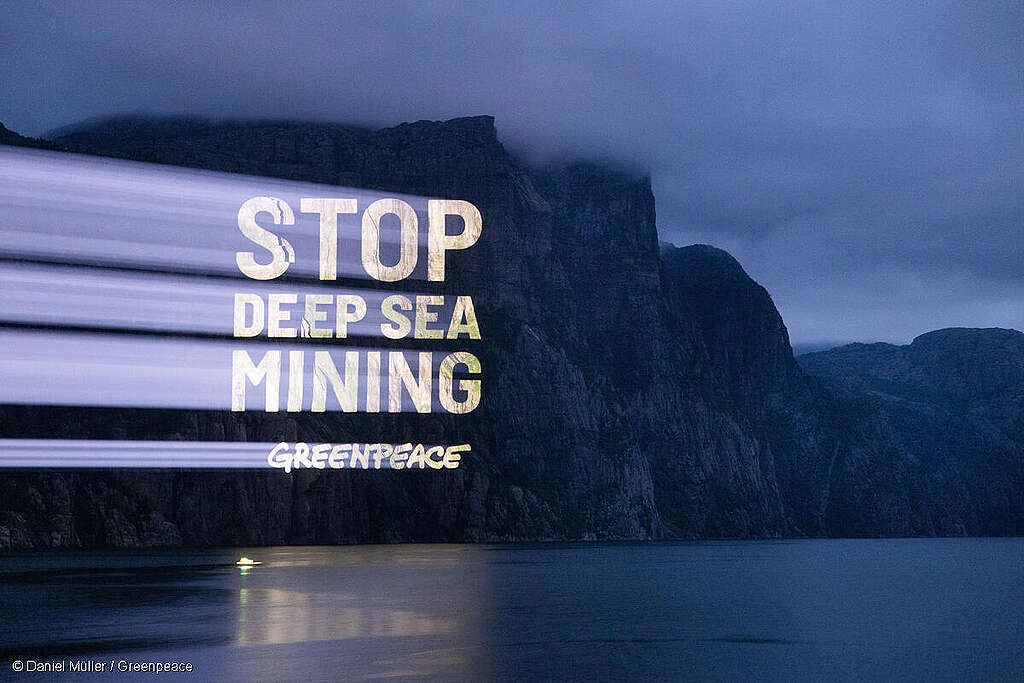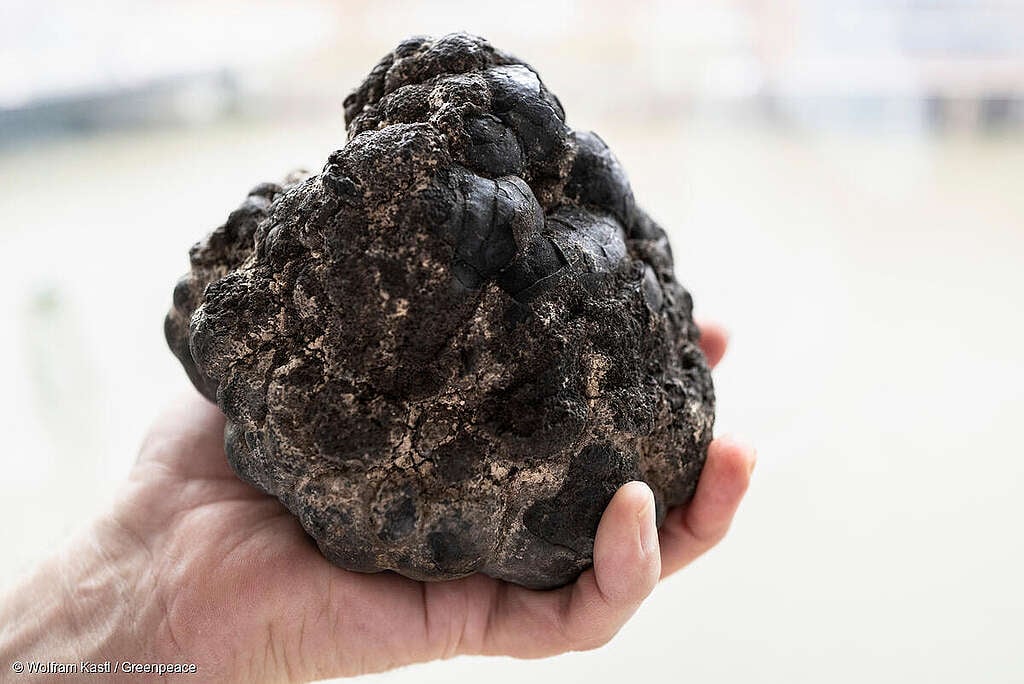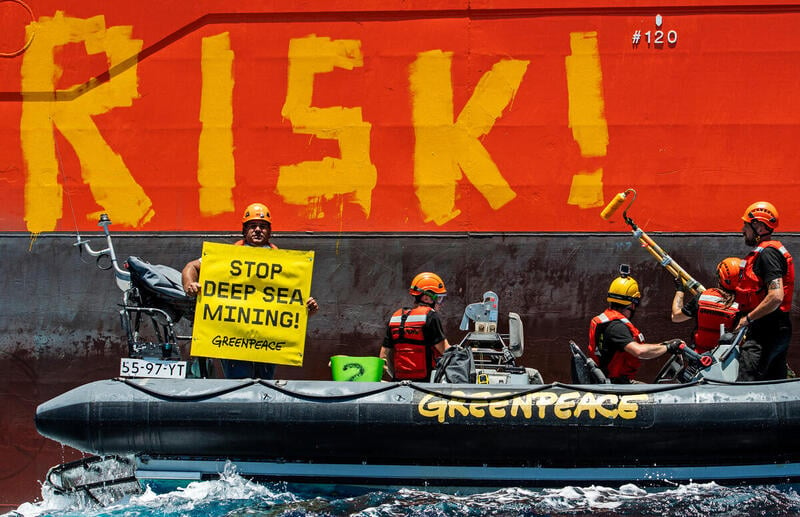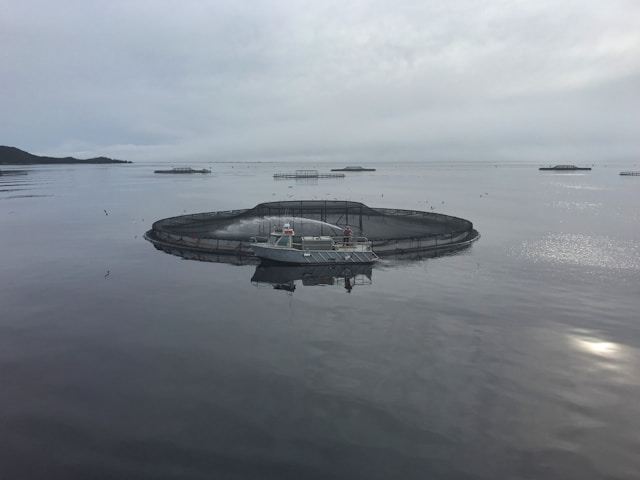
PETITION: Stop Deep Sea Mining
An emerging new industry could destroy this fragile and unique deep sea environment before we truly understand its importance.

Editor’s note: Protecting the ocean means life protection, our ecosystems depend on intact and clean oceans. Even though the aim is to protect 30% of the planet, it’s not clear what conservation actually means worldwide. That leads to ineffective conservation measures and demands more knowledge about oceanic ecosystems and also implementing it. For the most part protected areas don’t need to be managed, they just need to have humans leave them alone.
There’s never been more momentum for protecting the ocean, but new research finds that many efforts fail to protect endangered species — or have barely gotten off the drawing board.
Ocean ecosystems and the marine wildlife that depend on them are under threat as never before. Between overfishing, climate change, plastic pollution, and habitat destruction, it’s a bad time to be a prawn, cod, seabird, or whale.
There’s no single silver bullet solution to the biodiversity crisis, but in recent years, many people in the environmental community have focused on the goal of “30 x 30”: protecting 30% of the planet by the year 2030. Many nations have made promises toward that goal, including the United States, which has adapted it into the “America the Beautiful” initiative.
Measurable goals like this provide nations with clear, quantifiable conservation goals that others in the international community can follow, verify, or use to identify shortfalls and push for more action.
At the same time, many experts warn that number-based targets like “protect 30%” lend themselves to incentives to arguably-kinda-sorta protect as much as possible, rather than protecting the most ecologically important areas. Governments, for instance, can use what’s euphemistically referred to as “creative accounting” — counting things as protected that probably should not be considered protected.
Two new research papers examine some of this creative accounting in the ocean. Together, they stress important things to keep in mind when creating protected areas and when assessing their usefulness.
A surprisingly common issue in area-based conservation happens when a government declares a new protected area to help save a threatened species of concern…without first checking to see if the species actually lives within those boundaries.
It happens more often than you might think. A new study published in the Journal of Animal Ecology looked at 89 marine protected areas in Europe that are supposed to protect diadromous fish species (those that migrate between ocean and fresh water, like salmon or some eels) of conservation concern.
Their findings are shocking: Many of these areas protect habitats where those fish species do not live, and very few of them protect the most important core habitat for any diadromous fish species.
“A marine protected area should be an area that protects part of the marine environment,” says Sophie Elliott of the Wildlife Conservation Trust, the study’s lead author. “I say ‘should’ because there are a lot of parks that don’t have enough thought put into them. Quite often things are done quickly without thinking or understanding the situation.”
Sometimes this happens because of limited resources for scientific study. In other words, according to Elliot, we simply don’t know enough about species’ habitat use to protect their key habitat, at least not yet. This is known as the rare-species paradox: Endangered species are often hard to find and study, especially in the vast ocean, so it can be hard to understand what habitat qualities they need to thrive, even if we can hypothesize that protecting certain regions will mitigate some of the threats the species face.
Other times government officials, in search of positive publicity, announce a new protected area that was studied but wasn’t intended to protect a species.
“We had a series of MPAs that were supposed to have measures in place to protect certain species,” Elliott says. “But then an extra species got tacked on to the stated goals of the MPA, and it wasn’t effective for that species.” She declined to identify examples, given the political sensitivities of some of these protected areas.
In addition to gathering more data and always basing protected-area design on the best available data, Elliott recommends a more holistic approach to designating future protected areas.
“When people think about putting MPAs in place, look at the whole range of biodiversity that exists within it, because there might be many endangered and protected species,” she says. “You need to know what’s in that MPA and do ecosystem-based management” — management focusing on the whole ecosystem and not just individual species. It’s the difference between protecting cod by establishing fishing quotas versus protecting cod by also managing their habitat and predators and food and other things that eat that food. “We’ve long been calling for that, but we aren’t really working toward it at all,” she says.
Another key issue in marine protected area management is what should count as “protected.”
Some areas restrict oil and gas extraction but allow any and all fishing. Some allow swimmers and other recreation, while others say people can’t even go scuba diving.
In one glaring recent example, the advocacy group Oceana U.K. found evidence that the United Kingdom allows bottom trawling in many of its MPAs. Bottom trawling is a fishing method that’s extremely destructive to sensitive habitat types; it’s been compared to clear-cutting forests to catch rabbits.
“At the end of the day … there’s no one clear definition of what conservation means around the world,” says Angelo Villagomez, a senior fellow at the Center for American Progress who has studied the issue. “One of the negative externalities of the global push to protect 30% of the ocean is that some governments are more concerned with being able to say that they protected 30% of the ocean than they are concerned with delivering meaningful biodiversity protections.”
Villagomez and his colleagues have identified another big issue: According to their new analysis in the journal Conservation Letters, fully one-quarter of the 100 largest marine protected areas — as cataloged in the United Nations and IUCN’s world database of protected areas — are announced but not yet implemented. Many have no clear timeline of when the formal protections might be put into place, or what those regulations might look like.
For now, those areas exist on paper but remain unprotected in the real world. For example, the paper cites the OSPAR MPA network covering 7% of the Northeast Atlantic, which currently appears to have no concrete protections.
This wide range of rules and inconsistent protections makes it harder to protect the ocean — or to count it toward 30×30 goals.
Governments are not supposed to submit anything to the world database of protected areas until something is designated, “but they do, and that’s just the reality,” says Villagomez.
But here’s the biggest problem: The study found that many of the world’s largest MPAs lack the scientific knowledge, funding, and political support to be effective.
“We know that MPAs work when they are well designed and provided the funding to operate,” Villagomez told me. “But for about one-third of the MPAs we studied, based on everything we know about protected area science, they will never result in positive outcomes for biodiversity.”
The conclusions of these two papers are clear: Too many marine protected areas are poorly designed and sited in places where the species they’re ostensibly trying to protect do not actually live. Also, too many allow destructive extractive industries to operate, limiting the benefits of any protection.
Despite these setbacks, Villagomez remains optimistic about the future of MPA-based protections.
“The good news is that this works really well about one-third of the time — if you play baseball and you hit the ball 300 out of 1,000 times, you’re going to the Hall of Fame,” he says. “There’s a ton of science that shows that well-designed well-implemented MPAs work, and for one-quarter of the MPAS we looked at, they’re well designed and are just lacking funding for implementation.”

Nick Young 26 July 2024 / Greenpeace Scientists have found a source of ‘dark oxygen’ 4,000 meters below the surface of the Pacific in the target zone for deep sea mining. The discovery could have far-reaching implications for science and the wannabe deep sea mining industry. It’s often said that we know more about the surface of the moon than we do about the deep ocean. This new discovery of dark oxygen shows how true that is, and underlines the need to stop a new deep sea mining industry from targeting its source.
What scientists mean by ‘dark oxygen’ is that – in the total darkness of the very deep ocean – around 4,000 meters below the surface of the Pacific Ocean – oxygen is being produced – in the dark.
It’s previously been thought that oxygen on Earth is produced on land and at the surface of the ocean, where sunlight makes plant photosynthesis possible.
Plants on land are the biggest producers of oxygen, but marine algae and phytoplankton also produce it. These microscopic organisms perform photosynthesis in the ocean, which covers about 70% of the Earth’s surface.
Blue-green algae – or cyanobacteria – are some of the oldest organisms on Earth and can also produce oxygen. They were among the first to do so through photosynthesis, and they also need sunlight.
The common factor in oxygen production is sunlight – until this discovery of dark oxygen showed that oxygen is also being produced in another way in the deep dark sea.
The dark oxygen discovery is being hailed as a groundbreaking scientific discovery, but it also has other implications.
Nick Owens, the director of the Scottish Association for Marine Science (SAMS) says: “The fact that we’ve got another source of oxygen on the planet other than photosynthesis has consequences and implications that are utterly profound.”
Andrew Sweetman, who was one of the SAMS scientists involved in the research, says in a video: “This research potentially sheds light on where life began on the planet. This discovery has shown that, well, maybe there was another source of oxygen a long time ago and aerobic life or life that breathes oxygen could have persisted before the rise of photosynthesis — and if it’s happening on our planet could it be happening on other planets too?”
But as well as those wider implications, the discovery has significant and immediate implications for the controversial deep sea mining industry which somewhat ironically sponsored the science.
Here’s the thing. This dark oxygen, instead of being produced by plants and sunlight, is being produced by strange potato-shaped metallic lumps found on the deep sea floor.
It turns out that these lumps – otherwise known as ‘polymetallic nodules’ – give off almost as much electricity as AA batteries! By reacting with salt water, their electrical charge produces oxygen way down there on the seabed of the deep ocean through a process known as ‘seawater electrolysis’ which splits seawater into hydrogen and oxygen.

So, these little metallic lumps, which the wannabe deep sea miners have been metaphorically calling ‘batteries in a rock’ actually turned out to be just that – and they’re producing dark oxygen that could play a critical role in the deep ocean ecology.
The discovery of metallic nodules producing dark oxygen has been a huge surprise to science which could even require a new way of thinking about how life first began on planet Earth.
But it could also be the final straw in the case against deep sea mining. It could stop the industry before they begin.
The discovery was made in the Clarion-Clipperton Zone (CCZ), a huge flat area of the seafloor that stretches between Hawaii and Mexico, where mining companies like The Metals Company have plans to start harvesting these very same nodules that turn out to be producing all this dark oxygen.
These oxygen-producing nodules could be supporting a whole range of known and unknown deep sea lifeforms. Dark oxygen could be a critical factor in the deep sea ecosystem!

Greenpeace and others have long said that this new extractive mining industry should not be allowed to start in the very deep ocean because the life there is so little understood, and the ecosystems are fragile and potentially vital for the health of the ocean and all life on Earth.
This new discovery underlines the point.
The timing is good because world governments are meeting in Jamaica right now to decide the fate of this new mining industry. They’ll be deciding whether or not to allow deep sea miners like The Metals Company to go ahead with their plans to drop giant mining robots onto the seafloor to start harvesting these life-sustaining nodules.
Greenpeace is in Jamaica arguing strongly that deep sea mining should not be allowed to go ahead – especially now that we know the deep ocean is another source of oxygen that could be vital for the health of the ocean and all of us who depend on it.
In the climate and biodiversity crisis, we know that nature, in all its diversity, must be protected.

PETITION: Stop Deep Sea Mining
An emerging new industry could destroy this fragile and unique deep sea environment before we truly understand its importance.
Photo by Jong Marshes on Unsplash
For more information contact Deep Sea Defenders.

By Julia Conley Jun 26, 2024, for Common Dreams.
“The geoengineering approach puts Earth’s systems at risk in a faulty and false bid toward solving the climate crisis. It is what we call a false solution,” said one campaigner.
Biodiversity advocates on Wednesday called on the U.S. Environmental Protection Agency to reject a new geoengineering project spearheaded by researchers in Massachusetts that one critic said would do “nothing to solve the root causes of the climate crisis and instead puts at risk the oceans’ natural capacity to absorb carbon and their role in sustaining life on Earth.”
Friends of the Earth (FOE) and other groups warned that an experiment called LOC-NESS by the Woods Hole Oceanographic Institution (WHOI) carries “potentially catastrophic risks” for the Atlantic Ocean, where researchers have proposed dumping more than 60,000 gallons of sodium hydroxide near Cape Cod to test a “carbon dioxide removal approach” called Ocean Alkalinity Enhancement (OAE).
WHOI’s website states that the experiment would involve the release of “nontoxic, fluorescent Rhodamine WT dye into the ocean from a research ship,” with researchers tracking the dye’s movement over 72 hours in order to determine whether the ocean’s alkalinity could be enhanced.
If so, the scientists say, they could ultimately help to regulate atmospheric carbon.
The EPA’s notice about the proposed study from last month, however, says that the project “would involve a controlled release of a sodium hydroxide solution”—which is “essentially lye, a substance known to cause chemical burns and one that must be handled with great care,” according to Tom Goldtooth, co-founder and member of the board of directors of the national Climate Justice Alliance.
“It’s astonishing that the EPA is even considering allowing dangerous, caustic chemicals to be dumped in ocean waters that are frequented by at least eight endangered species, including right whales and leatherback turtles.”
“Altering the chemical composition of the ocean under the guise of increasing its capacity to absorb carbon dioxide is misleading and dangerous,” said Goldtooth. “An experiment centered on introducing this caustic substance into the sea should not be permitted… The geoengineering approach puts Earth’s systems at risk in a faulty and false bid toward solving the climate crisis. It is what we call a false solution.”
Friends of the Earth pointed out that WHOI’s permit application to the EPA acknowledges that after changing the ocean’s alkalinity, the researchers “have no direct way of measuring how much carbon dioxide will be removed by the experiment.”
“The production of alkaline materials is extremely energy-intensive, releasing similar or even higher levels of greenhouse gasses than they remove upon being dumped into the ocean,” said the group. “The researchers have declined to analyze how much carbon dioxide was released in the production, transportation, and dumping of the sodium hydroxide, making it impossible to know whether the technology even reduces greenhouse gas emissions.”
Despite these lingering questions, said FOE, the EPA has issued tentative approval for a permit for the experiment, with a public comment period open until July 1.
The caustic sodium hydroxide solution the researchers plan to use, warns FOE, “causes chemical burns upon contact with skin or marine animals, setting the stage for potentially extreme damage to local ecosystems.”
Benjamin Day, FOE’s senior campaigner for its Climate and Energy Justice Program, said the group “unequivocally” opposes the LOC-NESS geoengineering experiment in the fragile ecosystem off the coast of Cape Cod.
“It’s astonishing that the EPA is even considering allowing dangerous, caustic chemicals to be dumped in ocean waters that are frequented by at least eight endangered species, including right whales and leatherback turtles,” said Day.
Mary Church, geoengineering campaign manager for the Center for International Environmental Law, said “speculative technologies” like OAE are “a dangerous distraction from the real solutions to the climate crisis,” which scientists around the world agree requires a rapid reduction in planet-heating fossil fuel emissions through a large-scale shift to renewable energy sources.
“Marine geoengineering does nothing to solve the root causes of the climate crisis and instead puts at risk the oceans’ natural capacity to absorb carbon and their role in sustaining life on Earth,” said Church. “Outdoor experiments could not only cause immediate harm to marine life but are also a slippery slope to potentially catastrophic impacts of large-scale deployment.”
United Nations Convention on Biological Diversity has placed a moratorium on geoengineering techniques like OAE until there is “adequate scientific basis on which to justify such activities and appropriate consideration of the associated risks for the environment and biodiversity and associated social, economic, and cultural impacts.”
Photo by Taylor Rooney on Unsplash

Editor’s note: Sharks are beautiful, intelligent creatures, but they have been overexploited for decades. Because of their “high market value” industrial fisheries hunt sharks for their fins and other body parts. But it’s difficult to control the protection of the sea predators when they move to unprotected zones or international and local fleets fish in other countries’ fishery zones. The brutal killings of adults, babies, and even pregnant sharks happen while our culture is focused on buying more stuff and attending distracting events.
If sharks went extinct, it would set off a chain reaction. Sharks play an important role in the food chain. Smaller animals like shellfish may go extinct if there were no sharks to eat seals, for example. That would create a ripple effect, causing mass die-offs of otters, seals, and many types of fish due to food scarcity. The chain reaction would continue until its effects were felt on land, with fisheries collapsing in a matter of years. When will humanity wake up and start living with – not against other precious beings?
by: Assaf Levy, BioDB via Pressenza
Every year on July 14th, we celebrate Shark Awareness Day. It is not just a tribute to one of nature’s most misunderstood creatures; it is a call to action. Sharks have cruised the oceans for over 450 million years, playing a vital role in keeping marine ecosystems healthy. But today, these apex predators find themselves under increasing pressure, with many species teetering on the brink of extinction.
Hollywood might portray sharks as mindless killing machines, but this couldn’t be further from the truth. Sharks come in a staggering variety of shapes and sizes, from the filter-feeding giants like the whale shark to the sleek and speedy blue shark. They possess incredible senses, like electroreception, that allows them to detect electrical fields emitted by prey, and an amazing ability to navigate vast distances.
As apex predators, they help maintain the balance by regulating the populations of species below them in the food chain. This includes controlling the numbers of mid-level predators and helping to ensure species diversity among smaller fish and invertebrate populations. Their feeding habits help keep marine ecosystems healthy and functional. For instance, by preying on weak or sick individuals, sharks help prevent the spread of disease and ensure a healthier gene pool within the prey population. Their disappearance could have devastating consequences, leading to population explosions of prey species and ultimately, the collapse of entire ecosystems.
Despite their importance, many shark species are alarmingly close to extinction. According to the International Union for Conservation of Nature (IUCN), over one-third or 30% of shark species are either vulnerable, endangered or critically endangered. Some of the most threatened species include the Great Hammerhead, the Oceanic whitetip, and the Basking shark.
The main culprit behind this is overfishing. Driven by demand for shark fins (a prized ingredient in shark fin soup) and meat, millions of sharks are caught every year, often through unsustainable practices like finning, where fins are removed and the body discarded.
Another major threat is habitat loss. Sharks rely on healthy coral reefs and mangroves for breeding and feeding. However, these vital ecosystems are being degraded by pollution, climate change, and coastal development.
The silver lining in the story of sharks is the growing awareness and effort towards their conservation. Governments, NGOs, and international bodies are working together to protect these magnificent creatures:
Another example is the Jardines de la Reina National Park in Cuba, which has been particularly successful in conserving shark populations. This MPA provides a refuge for several species of sharks and has implemented strict no-take policies and eco-tourism guidelines that help maintain the health and biodiversity of its waters.
Deadly predators,
Under the sea and on land
But, what’s more deadly?
A razor sharp, swimming shark
Or the end of marine life?
Poem by @saf_begum
This Shark Awareness Day, let’s not only admire the majestic Great Whites and the elusive deep-sea dwellers but also ignite a global commitment to safeguard their future. Every shark species plays a pivotal role in marine ecosystems, balancing marine life and ensuring the health of our oceans.
Today, we must transcend admiration and take decisive action. Let’s pledge to protect these magnificent creatures, understanding that saving sharks is fundamentally about preserving the entire marine ecosystem. By protecting sharks, we are not just saving individual species; we are investing in the health and sustainability of our entire ocean. Join us in this crucial mission—educate, advocate, and participate. Together, we can turn the tide for sharks and secure a vibrant future for our blue planet.

Editor’s note: The author asks if that is a good thing. The short answer is no. For the same reason, agriculture is bad for the land, aquaculture is bad for the ocean. It is because humans have overcaught wild fish and depleted their numbers that people have more and more gone to aquaculture. There are now just too many human mouths to feed and not enough fish in the oceans.
By Frida Garza / Grist
A new report from the United Nations’ Food and Agriculture Organization, or FAO, has found that more fish were farmed worldwide in 2022 than harvested from the wild, an apparent first.
Last week, the FAO released its annual report on the state of aquaculture — which refers to the farming of both seafood and aquatic plants — and fisheries around the world. The organization found that global production from both aquaculture and fisheries reached a new high — 223.3 million metric tons of animals and plants — in 2022. Of that, 185.4 million metric tons were aquatic animals, and 37.8 million metric tons were algae. Aquaculture was responsible for 51 percent of aquatic animal production in 2022, or 94.4 metric tons.
The milestone was in many ways an expected one, given the world’s insatiable appetite for seafood. Since 1961, consumption of seafood has grown at twice the annual rate of the global population, according to the FAO. Because production levels from fisheries are not expected to change significantly in the future, meeting the growing global demand for seafood almost certainly necessitates an increase in aquaculture.
Though fishery production levels fluctuate from year to year, “it’s not like there’s new fisheries out there waiting to be discovered,” said Dave Martin, program director for Sustainable Fisheries Partnerships, an international organization that works to reduce the environmental impact of seafood supply chains. “So any growth in consumption of seafood is going to come from aquaculture.”

But the rise of aquaculture underscores the need to transform seafood systems to minimize their impact on the planet. Both aquaculture and fisheries — sometimes referred to as capture fisheries, as they involve the capture of wild seafood — come with significant environmental and climate considerations. What’s more, the two systems often depend on each other, making it difficult to isolate their climate impacts.
“There’s a lot of overlap between fisheries and aquaculture that the average consumer may not see,” said Dave Love, a research professor at the Center for a Livable Future at Johns Hopkins University.
Studies have shown that the best diet for the planet is one free of animal protein. Still, seafood generally has much lower greenhouse gas emissions than other forms of protein from land-based animals. And given many people’s unwillingness or inability to go vegan, the FAO recommends transforming, adapting, and expanding sustainable seafood production to feed the world’s growing population and improve food security.
But “there’s a lot of ways to do aquaculture well, and there’s a lot of ways to do it poorly,” said Martin. Aquaculture can result in nitrogen and phosphorus being released into the natural environment, damaging aquatic ecosystems. Farmed fish can also spread disease to wild populations, or escape from their confines and breed with other species, resulting in genetic pollution that can disrupt the fitness of a wild population. Martin points to the diesel fuel used to power equipment on certain fish farms as a major source of aquaculture’s environmental impact. According to an analysis from the climate solutions nonprofit Project Drawdown, swapping out fossil fuel-based generators on fish farms for renewable-powered hybrids would prevent 500 million to 780 million metric tons of carbon emissions by 2050.
Other areas for improvement will vary depending on the specific species being farmed. In 2012, a U.N. study found that mangrove forests — a major carbon sink — have suffered greatly due to the development of shrimp and fish farming. Today, industry stakeholders have been exploring how new approaches and techniques from shrimp farmers can help restore mangroves.
Meanwhile, wild fishing operations present their own environmental problems. For example, poorly managed fisheries can harvest fish more quickly than wild populations can breed, a phenomenon known as overfishing. Certain destructive wild fishing techniques also kill a lot of non-targeted species, known as bycatch, threatening marine biodiversity.
But the line between aquaculture and fish harvested from the wild isn’t as clear as it may seem. For example, pink salmon that are raised in hatcheries and then released into the wild to feed, mature, and ultimately be caught again are often marketed as “wild caught.” Lobsters, caught wild in Maine, are often fed bait by fisherman to help them put on weight. “It’s a wild fishery,” said Love — but the lobster fishermen’s practice of fattening up their catch shows how human intervention is present even in wild-caught operations.
On the flipside, in a majority of aquaculture systems, farmers provide their fish with feed. That feed sometimes includes fish meal, says Love, a powder that comes from two sources: seafood processing waste (think: fish guts and tails) and wild-caught fish.
All of this can result in a confusing landscape for climate- or environmentally-conscientious consumers who eat fish. But Love recommends a few ways in which consumers can navigate choice when shopping for seafood. Buying fresh fish locally helps shorten supply chains, which can lower the carbon impact of eating aquatic animals. “In our work, we’ve found that the big impact from transport is shipping fresh seafood internationally by air,” he said. Most farmed salmon, for example, sold in the U.S. is flown in.
From both a climate and a nutritional standpoint, smaller fish and sea vegetables are also both good options. “Mussels, clams, oysters, seaweed — they’re all loaded with macronutrients and minerals in different ways” compared to fin fish, said Love.
This story was originally published by Grist. Sign up for Grist’s weekly newsletter here.
Photo by Datingscout on Unsplash